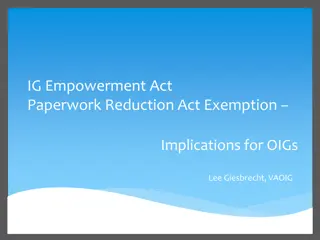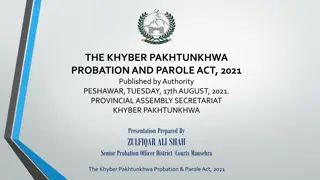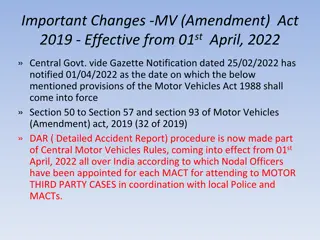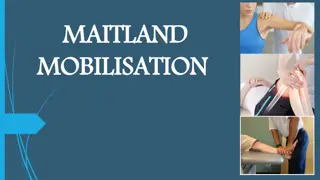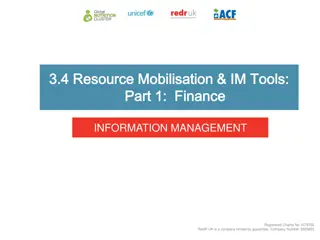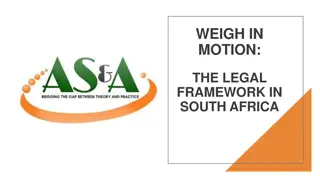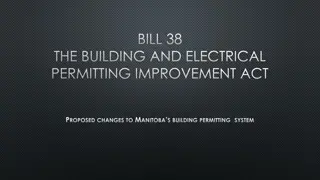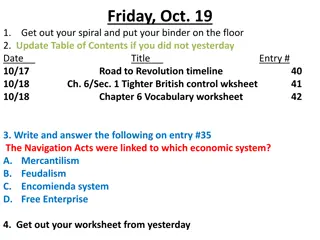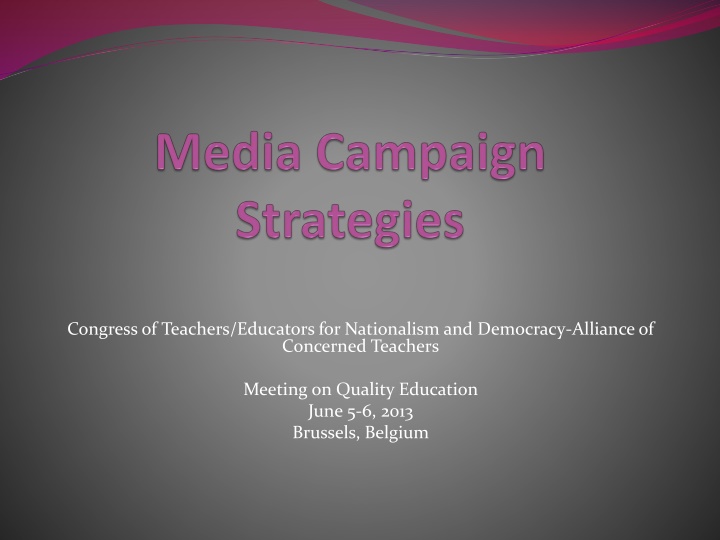
Teachers Congress Meeting on Quality Education and Social Mobilization
Explore the initiatives and objectives of the Congress of Teachers/Educators for Nationalism and Democracy during their meeting in Brussels. Learn about campaigns, social issues, and mobilization efforts to promote quality education and advocate for social welfare. Discover guiding principles and media campaign materials focusing on educational reform and social justice.
Download Presentation

Please find below an Image/Link to download the presentation.
The content on the website is provided AS IS for your information and personal use only. It may not be sold, licensed, or shared on other websites without obtaining consent from the author. If you encounter any issues during the download, it is possible that the publisher has removed the file from their server.
You are allowed to download the files provided on this website for personal or commercial use, subject to the condition that they are used lawfully. All files are the property of their respective owners.
The content on the website is provided AS IS for your information and personal use only. It may not be sold, licensed, or shared on other websites without obtaining consent from the author.
E N D
Presentation Transcript
Congress of Teachers/Educators for Nationalism and Democracy-Alliance of Concerned Teachers Meeting on Quality Education June 5-6, 2013 Brussels, Belgium
Campaigns AOM 3 main objectives AROUSE! ORGANIZE! MOBILIZE!
AROUSE Social Issues that will promote: 1. Welfare & benefits/ economic rights 2. Solidarity within the sector and with other sectors in society: Defense of human rights, national sovereignty, peace based on justice Local-National issues:Make A Connection
ORGANIZE and MOBILIZE Who? Fellow teachers, government employees, students For what? 1.popularization of the issue 2.take a stand 3.join mobilizations mass demonstrations, lobbying, petition signing 4. join creative forms of popularization of issues: performance flash mobs, teach- ins, run for a cause 5. active union membership How? Forums, Film Showing, Exhibits, Media work: contributions to broadsheets, columns and other dailies, release of statements
Guiding Principles 1. Popularization of mass campaigns social scientific research = concrete analysis of concrete conditions HOW? immersion and integration: regular dialogue with fellow teachers, students, rank and file employees, basic sectors
Guiding Principles 2. Raising of standards in terms of understanding issues and mass campaigns We are not necessarily introducing something new. We are only raising a normalized, naturalized , institutionalized, and therefore rarely unexplored dimension of what we have always known. Mainstream mass media have a way of naturalizing and normalizing the sordid state of public education. While it focuses on the harsh conditions within the education sector (quality, homeless teachers, etc.), it tends to highlight individual misery, and subtracts this from the whole as though it is an isolated case instead of exposing how neoliberal policies of the state systematically shape our educational system.
Media Campaign Materials SCRAP STFAP Socialized Tuition Fee Assistance Program
the long and painful line for student loans
I I want to prove to everyone that poverty should not be an obstacle to education. And through your assistance, I may be able to be of service to our people by becoming a doctor -Kristel Tejada 1997-2013 University of the Philippines-Manila
JFK- Justice for Kristel Tejada Militant workers union, Kilusang Mayo Uno (KMU May One Movement) mobilizing for education
Media Campaign Materials on K-12 http://opinion.inquirer.net/30887/k-to-12-lengthens-the-suffering-increases-the-burden It s true that the Philippines is one of the few countries that have only four years of secondary education. It s also true that with a conservative figure of 35 students per teacher in high school, the Philippines has currently the worst teacher- student ratio in the secondary level of education in East Asia and the Pacific. Malaysia and Singapore have a ratio of 14 pupils per teacher, Thailand 19, Indonesia 12, and Vietnam 18. It likewise cannot be denied that the Philippines allocates a measly 2.6 percent of the annual Gross Domestic Product (GDP) to the total education budget in contrast to Indonesia, Thailand and Singapore, which allot more than 3 percent. Vietnam, on the other hand, allocates more than 5 percent, while Malaysia spends close to the ideal 6 percent yearly. Industrialized nations spend on average 6 percent of their GDP on education. The lack of adequate budget and resources has consistently been identified in the past as the main reason for the deterioration and demoralization of Philippine education. (All data cited represent the latest available from Unesco.) Bhutan, the setting of the fictional Kingdom of Yangdon in the telenovela The Princess and I, underwent a transition similar to that which the Philippines will undergo under the so-called K to 12 program. In 2003, Bhutan lengthened secondary education from four to six years. It may be a poorer country than the Philippines in many respects but it seems to have a better sense of educational priorities. It s true that the Philippines is one of the few countries that have only four years of secondary education. It s also true that with a conservative figure of 35 students per teacher in high school, the Philippines has currently the worst teacher-student ratio in the secondary level of education in East Asia and the Pacific. Malaysia and Singapore have a ratio of 14 pupils per teacher, Thailand 19, Indonesia 12, and Vietnam 18.
Media Campaign-12 http://www.sunstar.com.ph/cagayan-de-oro/opinion/2013/04/26/alamon-mantra-279519 It is a practice taught to them by their teacher who meant to inspire the students to rise above their circumstances and aspire for higher education despite the odds. And the odds are formidable. AAccording to recent national dropout rates, for every 10 students that enter grade 1, only 4 of them will reach college. However, only 1 of this 4, out of the 10, will be able to complete higher learning. This means that for every 100 grade 1 students, only 10 will be able to finish college. And for most Filipino families, the culmination of this educational journey is the attainment of a college diploma. Parents would beg and almost lie and steal just to secure the future of their children with a college degree. And yet here comes the K to 12 program by the DepEd which strangely, instead of addressing this problem of access to higher learning, offer even greater obstacles to the attainment of a college education. In fact, to my mind, the program is designed to completely do away with college education as a Filipino aspiration especially among the poor.
Form and Content learned and habituated know how practical inter- cultural sense complement original cultural and political perspectives without inspiring the need to abandon them in favorof taking in new ones. Encourage people to appreciate issues, develop a sense of understanding for previous information, and even strange situations. the necessity of ASSESSMENTS soon after each campaign before planning on a new one





